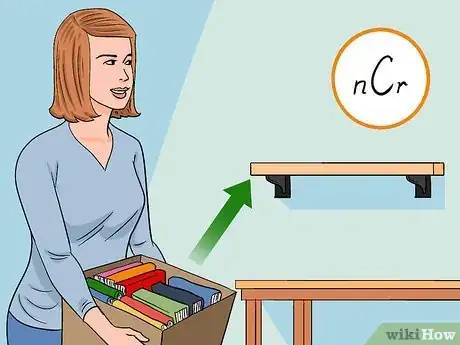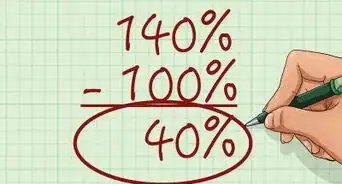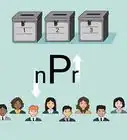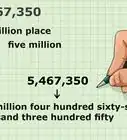wikiHow is a “wiki,” similar to Wikipedia, which means that many of our articles are co-written by multiple authors. To create this article, volunteer authors worked to edit and improve it over time.
There are 7 references cited in this article, which can be found at the bottom of the page.
This article has been viewed 94,572 times.
Learn more...
Permutations and combinations have uses in math classes and in daily life. Thankfully, they are easy to calculate once you know how. Unlike permutations, where group order matters, in combinations, the order doesn't matter.[1] Combinations tell you how many ways there are to combine a given number of items in a group. To calculate combinations, you just need to know the number of items you're choosing from, the number of items to choose, and whether or not repetition is allowed (in the most common form of this problem, repetition is not allowed).
Steps
Calculating Combinations Without Repetition
-
1Consider an example problem where order does not matter and repetition is not allowed. In this kind of problem, you won't use the same item more than once.
- For instance, you may have 10 books, and you'd like to find the number of ways to combine 6 of those books on your shelf. In this case, you don't care about order - you just want to know which groupings of books you could display, assuming you only use any given book once.
- This kind of problem is often labeled as , , , or "n choose r".
- In all of these notations, is the number of items you have to choose from (your sample) and is the number of items you're going to select.[2]
-
2Know the formula: .[3] [4]
- The formula is similar the one for permutations but not exactly the same. Permutations can be found using . The combination formula is slightly different because order no longer matters; therefore, you divide the permutations formula by in order to eliminate the redundancies.[5] You are essentially reducing the result by the number of options that would be considered a different permutation but the same combination (because order doesn't matter for combinations).[6] [7]
Advertisement -
3Plug in your values for and .
- In the case above, you would have this formula: . It would simplify to .
-
4Solve the equation to find the number of combinations. You can do this either by hand or with a calculator.
- If you have a calculator available, find the factorial setting and use that to calculate the number of combinations. If you're using Google Calculator, click on the x! button each time after entering the necessary digits.
- If you have to solve by hand, keep in mind that for each factorial, you start with the main number given and then multiply it by the next smallest number, and so on until you get down to 0.
- For the example, you can calculate 10! with (10 * 9 * 8 * 7 * 6 * 5 * 4 * 3 * 2 * 1), which gives you 3,628,800. Find 4! with (4 * 3 * 2 * 1), which gives you 24. Find 6! with (6 * 5 * 4 * 3 * 2 * 1), which gives you 720.
- Then multiply the two numbers that add to the total of items together. In this example, you should have 24 * 720, so 17,280 will be your denominator.
- Divide the factorial of the total by the denominator, as described above: 3,628,800/17,280.
- In the example case, you'd do get 210. This means that there are 210 different ways to combine the books on a shelf, without repetition and where order doesn't matter.
Calculating Combinations with Repetition
-
1Consider an example problem where order does not matter but repetition is allowed. In this kind of problem, you can use the same item more than once.
- For instance, imagine that you're going to order 5 items from a menu offering 15 items; the order of your selections doesn't matter, and you don't mind getting multiples of the same item (i.e., repetitions are allowed).
- This kind of problem can be labeled as . You would generally use to represent the number of options you have to choose from and to represent the number of items you're going to select.[8] Remember, in this kind of problem, repetition is allowed and the order isn't relevant.
- This is the least common and least understood type of combination or permutation, and isn't generally taught as often.[9] Where it is covered, it is often also known as a k-selection, a k-multiset, or a k-combination with repetition.[10]
-
2
-
3Plug in your values for and .
- In the example case, you would have this formula: . It would simplify to .
-
4Solve the equation to find the number of combinations. You can do this either by hand or with a calculator.
- If you have a calculator available, find the factorial setting and use that to calculate the number of combinations. If you're using Google Calculator, click on the x! button each time after entering the necessary digits.
- If you have to solve by hand, keep in mind that for each factorial, you start with the main number given and then multiply it by the next smallest number, and so on until you get down to 0.
- For the example problem, your solution should be 11,628. There are 11,628 different ways you could order any 5 items from a selection of 15 items on a menu, where order doesn't matter and repetition is allowed.
Community Q&A
-
QuestionFor: 6 starters 10 mains 7 desserts, how many different three course meals?
 WikiaWangTop AnswererYou can use what is called a “counting method” or by creating a tree. You don’t actually need the formula; you can simply do 6x10x7 and you will get the answer, which is 420.
WikiaWangTop AnswererYou can use what is called a “counting method” or by creating a tree. You don’t actually need the formula; you can simply do 6x10x7 and you will get the answer, which is 420. -
QuestionHow many combinatioons of 2 are in 32 numbers?
 WikiaWangTop AnswererThere are 496 combinations without repetition. Here’s the formula: 32!/(32-2)!*2! = 32*31/2! = 496.
WikiaWangTop AnswererThere are 496 combinations without repetition. Here’s the formula: 32!/(32-2)!*2! = 32*31/2! = 496.
References
- ↑ https://www.calculatorsoup.com/calculators/discretemathematics/combinations.php
- ↑ https://betterexplained.com/articles/easy-permutations-and-combinations/
- ↑ https://betterexplained.com/articles/easy-permutations-and-combinations/
- ↑ https://www.mathsisfun.com/combinatorics/combinations-permutations.html
- ↑ https://betterexplained.com/articles/easy-permutations-and-combinations/
- ↑ https://medium.com/i-math/combinations-permutations-fa7ac680f0ac
- ↑ https://www.mathsisfun.com/combinatorics/combinations-permutations.html
- ↑ https://betterexplained.com/articles/easy-permutations-and-combinations/
- ↑ https://www.quora.com/What-is-Combinations-with-repetition








































































